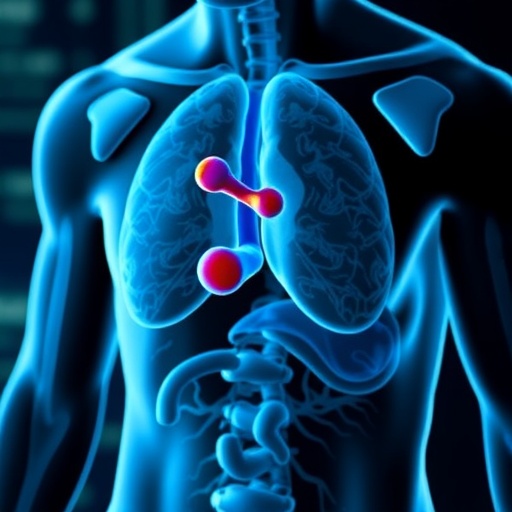In the relentless battle against prostate cancer, scientists have unveiled a fascinating and potentially game-changing role for a class of adrenal-derived hormones known as 11-oxyandrogens. This emerging research sheds new light on the complex mechanisms that fuel the most stubborn form of prostate cancer—metastatic castration-resistant prostate cancer (mCRPC). The discoveries could herald a new chapter in targeted therapies, improving patient outcomes in a disease that has long challenged clinicians.
Prostate cancer’s progression is tightly linked to the androgen receptor (AR) signaling pathway, which drives tumor growth by responding to androgens, the male hormones. While conventional therapies focus on suppressing testosterone and its canonical derivatives, recent evidence highlights 11-oxyandrogens—specifically 11-ketotestosterone (11KT) and 11β-hydroxytestosterone (11OHT)—as potent activators of the AR. These hormones, produced primarily by the adrenal glands, outnumber traditional androgens in circulation, hinting at a significant influence within the tumor microenvironment.
A pioneering pilot study involving 35 patients with mCRPC, all beginning treatment with androgen receptor pathway inhibitors (ARPI), harnessed the power of mass spectrometry to meticulously quantify serum steroid levels. This rigorous approach forged crucial correlations between 11-oxyandrogen concentrations and clinical outcomes, particularly progression-free survival (PFS). Surprisingly, patients with higher baseline levels of 11KT, 11OHT, and their precursors exhibited a notably prolonged PFS, suggesting that these hormones may paradoxically predict a better response to ARPI treatment.
Functional laboratory experiments delved deeper into the biology underpinning these observations. When mCRPC cells were exposed to 11KT and 11OHT, marked stimulation of AR-driven proliferation ensued, mirroring the behavior of canonical androgens. Crucially, this effect was completely hampered by enzalutamide, a potent AR antagonist commonly used in clinical settings, confirming the AR-dependent nature of 11-oxyandrogen signaling. Beyond merely promoting tumor growth, these hormones modulated gene expression patterns integral to cancer progression.
Intriguingly, the research revealed that 11-oxyandrogens exert distinct biological effects beyond AR activation. Transcriptomic and proteomic profiling illuminated pathways that diverged from classical androgen signaling, implicating AR-independent mechanisms. These findings expand the conceptual landscape of androgen biology in prostate cancer and suggest that targeting 11-oxyandrogen synthesis or downstream effects may require complementary therapeutic strategies.
The central role of 11-oxyandrogens in mCRPC challenges existing paradigms that have predominantly emphasized testosterone and dihydrotestosterone (DHT) as the primary drivers of AR activation. This shift compels a re-examination of endocrine dynamics, especially considering that 11-oxygenated androgens contribute to over 80% of the circulating androgen pool in these patients. Their robust presence redefines the hormonal milieu influencing tumor behavior and therapeutic resistance.
From a clinical perspective, the association between elevated 11-oxyandrogen levels and improved responsiveness to ARPIs is paradoxical yet compelling. It may reflect a tumor phenotype heavily reliant on AR signaling, which, despite aggressive disease, remains susceptible to targeted AR inhibition. This insight paves the way for refined biomarker development, enabling oncologists to stratify patients likely to benefit most from ARPI therapy and tailor treatment regimens accordingly.
Moreover, the complex interplay between adrenal-derived 11-oxyandrogens and prostate cancer cells underscores the importance of systemic factors in cancer progression. The adrenal glands emerge not just as bystanders but as active contributors to the endocrine environment that fosters tumor growth, particularly under conditions of androgen deprivation. Understanding this axis could stimulate innovative approaches to disrupt hormone-mediated cancer proliferation.
The research team’s utilization of cutting-edge mass spectrometry established a gold standard for steroid analysis, offering a robust and precise quantification method that surpasses traditional immunoassays. This technological rigor ensures the reliability of findings and sets a precedent for future longitudinal studies assessing steroid biomarkers in oncology.
Importantly, the study’s transcriptomic and proteomic analyses unveiled novel gene expression signatures and protein networks modulated by 11-oxyandrogens. These molecular fingerprints provide a blueprint for deciphering the multifaceted effects of these hormones and identify potential targets for pharmacologic intervention beyond AR antagonism.
This comprehensive exploration of 11-oxyandrogens opens new investigative avenues, particularly in understanding mechanisms of resistance to current ARPI treatments. Given the partial activation of AR-independent pathways by these hormones, combination therapies targeting multiple signaling cascades may become necessary to overcome therapeutic escape and achieve durable responses.
The findings also prompt re-evaluation of androgen metabolism in prostate cancer, suggesting that the enzymatic pathways generating 11-oxyandrogens could be novel therapeutic targets. Inhibitors of specific enzymes involved in the biosynthesis or metabolism of these steroids might complement existing ARPIs, offering a two-pronged attack on tumor growth.
From a translational standpoint, routine assessment of 11-oxyandrogen levels in clinical practice could revolutionize personalized cancer care. Integrating these biomarkers could assist in early identification of patients with hormonally active tumors more likely to respond to AR pathway inhibition, enhancing treatment precision and sparing others from ineffective therapies.
While the study’s pilot nature necessitates validation in larger, multicenter cohorts, its implications resonate across the spectrum of prostate cancer management. The potential to leverage 11-oxyandrogen profiling to predict treatment response brings the field closer to realizing truly precision oncology in men’s health.
In sum, this groundbreaking research redefines the androgenic landscape in castration-resistant prostate cancer by accentuating the pivotal role of 11-oxyandrogens. It establishes these hormones as powerful drivers of AR activation and potential modulators of tumor biology, with profound clinical relevance for therapy selection and prognostication. The path forward involves unraveling the intricacies of their signaling pathways and harnessing this knowledge to improve outcomes for patients confronting this formidable disease.
As the scientific community continues to decode the hormonal intricacies underpinning mCRPC, the elucidation of 11-oxyandrogens’ role emerges as a beacon of hope. With further research and clinical translation, we stand at the cusp of innovative strategies that may finally tilt the scales in favor of patients battling advanced prostate cancer.
Subject of Research: The role of adrenal-derived 11-oxyandrogens in the progression and treatment response of metastatic castration-resistant prostate cancer.
Article Title: Androgenic effects of 11-oxyandrogens in castration-resistant prostate cancer.
Article References:
Lapointe-Belleau, A., Rouleau, M., Villeneuve, L. et al. Androgenic effects of 11-oxyandrogens in castration-resistant prostate cancer.
BMC Cancer 25, 1786 (2025). https://doi.org/10.1186/s12885-025-15193-7
Image Credits: Scienmag.com
DOI: 10.1186/s12885-025-15193-7 (Published 19 November 2025)




